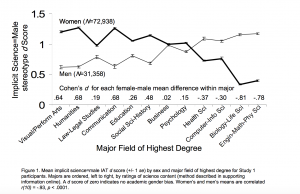Hands-on Learning in STEM: Why is it so important?
Like many other elementary-age students, boxed science kits were a staple of my childhood. From growing sugar crystals to making glow-in-the-dark slime, I spent many an afternoon stirring concoctions and testing my experiments. I couldn’t have known it at the time, but practicing science in a hands-on, experimental way was changing the structure of my growing brain. Not only was it fostering a future interest in science, but it was also improving my scientific knowledge and abilities in STEM. Though boxed science kits surely aren’t the only way to do these things, hands-on scientific learning is crucial to a career in a STEM field. Interestingly enough, there may be gender differences in the amount of hands-on learning that children and older students engage in. For this reason, hands-on learning may play an important role in the gender gap we see in STEM fields.
The Big Two: Ability and Interest
Though there are many complex reasons why people choose certain careers, we can summarize the bulk of these reasons in two words: ability and interest. People tend to choose fields they 1) believe they are good at and 2) are passionate about. Job hours, prestige, and salary certainly also play into the equation, but are most often secondary factors. Access to hands-on learning plays a major role in both ability to do a certain job and interest in that career path.
Ability
There is certainly evidence that life experiences change the physical architecture of the brain, thus influencing its functioning. For example, in a well-known study on London cab drivers, it was found that the cab drivers had enlarged portions of their right posterior hippocampus relative to adults that did not require visual-spatial skills for their career. Cab drivers need complex way-finding skills to drive customers to where they need to be, skills that activate the right posterior hippocampus region of the brain. Interestingly, the study also found that the longer the person had been a cab driver, the more enlarged this region of the brain was (Halpern, 2007). Studies like this one suggest that cognitive ability is highly dependent upon life experiences and repeated training. This example discussed visual-spatial skills, but life experiences also build a number of other skills (such as mathematical ability and mental rotation skills) that are widely acknowledged to be important in STEM careers (Uttal, 2012). For this reason, opportunities for hands-on engagement in STEM activities that start at early ages may be crucial in building the skills that are needed for STEM professions.
Interest
In addition to physically changing certain regions of the brain, hands-on experience can also have a major impact on interest in particular fields. In a 2010 study, the effect of hands-on biological experiments on interest in those biological topics was investigated. It was found that, in general, interest levels of students who had performed hands-on experiments were higher than those who didn’t have hands-on exposure to the topic (Holstermann, 2010). Fostering an early interest in a certain topic can lead that person to seek out more related hands-on activities, increasing interest levels, and so on. Interest and passion are two of the most important factors in career choice and are also important qualities employers search for in job candidates.
Gender Differences
Unfortunately, access to the hands-on experience needed to build skills and interest in STEM fields may differ between males and females. Computer access in schools is one example; particularly in economically disadvantaged school districts, ability to use the computer often favors male students (DuBois, P. A., 1986). This situation may be improving as technology becomes increasingly common in the classroom, but teacher and parent encouragement for girls to participate in STEM activities may not be. Studies have shown that, when her children are engaged in a hands-on scientific activity, mothers are more likely to talk with their sons about the scientific process than they are with their daughters. This parental discussion and encouragement is important; interestingly, the amount of “science talk” the mothers engaged their child in correlated positively with the child’s later understanding of scientific texts (Hyde, 2007). In another similar study, parents and children in a museum were observed. When children were engaged in an interactive science exhibit, the parents were “three times more likely to explain science to boys than to girls” (Hyde, 2007). These studies show an unsettling gender gap in how parents react to their children’s engagement in hands-on science. Given that hands-on experimentation is a crucial factor in building the skills and interest needed for a STEM career, unequal access and encouragement to participate in hands-on learning may be a component in explaining the gender career gap.
Though ability and interest are indeed two of the most important factors in determining career paths, it is important to acknowledge that these factors are not solely shaped by environmental influences. There are certainly genetic factors that may predispose a strong ability or interest in STEM. Environmental components however, including hands-on learning and STEM experimentation, have been shown play an appreciable role. Ensuring that males and females have equal access to technology and science experiments, while also working to reduce gender biases surrounding hands-on learning in STEM at home and in the classroom, would allow males and females an equal opportunity to build STEM skills and interest early on in their education. If more females have the ability and the interest to pursue a career in STEM, then maybe the gender gap we see in STEM careers will come closer to closing. By explaining the scientific process to our girls at museums, or picking out a boxed science kit on glow-in-the-dark slime for her birthday, we are giving girls an equal opportunity to build the skills and the interest they need to pursue a career in STEM.
References:
DuBois, P. A., Schubert, J. G. (1986). “Do your school policies provide equal access to computers? Are you sure?” Association for Supervision and Curriculum Development. http://www.ascd.org/ASCD/pdf/journals/ed_lead/el_198603_dubois.pdf
Halpern, D. F. (2007). “Science, sex, and good sense”. Why Aren’t More Women in Science? S. J. Ceci, W. M. Williams (Ed.). Washington, DC: American Psychological Association.
Holstermann, N., Grube, D., Bögeholz, S. (2010). “Hands-on activities and their interest on students’ interest”. Research in Science Education, 40(5), 743-757.
Hyde, J. S. (2007). “Women in science: Gender similarities in abilities and sociocultural forces”. Why Aren’t More Women in Science? S. J. Ceci, W. M. Williams (Ed.). Washington, DC: American Psychological Association.
Uttal, D. H., Cohen, C. A. (2012). “Spatial thinking and STEM education: When, why, and how? Psychology of Learning and Motivation, 57, 147-181. http://groups.psych.northwestern.edu/uttal/documents/UttalandCohen.pdf
Posted in Uncategorized
Bringing Home the Bacon: How Do Familial and Societal Expectations Shape Future Performance and Career Paths?
As a female entering her teenage years, I was given plenty of advice about how to choose “Mr. Right”.
“Find a man who respects you!”
“It’s important to have a man who can make you laugh.”
“Make sure the man you choose can support you!”
Though well meaning, some of this advice – from family, friends, or acquaintances – contained underlying assumptions about my life goals and expectations for myself. The last piece of advice, for example, is one that I heard many variations of throughout my preteen and teen years. My family in particular, wanted to be sure I would have a husband that could provide for me and take care of me when I was no longer under their care. This advice, of course, stemmed only out of love for me. Yet, finding a man that could support me – in other words, a doctor or engineer or scientist with a hefty salary – implied that, without a man, I would be unable to support myself. I needed a man – to provide for me and to protect me from the big, scary “real world”.
Men experience a variation of this same bias. Familial and societal pressures can help instill in them the unconscious belief that they need to be those providers – if they want a woman, they are going to have to be able to make the money that she can use to get her nails done and buy her shoes. In order to do that, they need the hefty salary that comes with being a doctor or an engineer or a scientist. In short, it’s his responsibility to “bring home the bacon”. These expectations for men and women – perpetuated by families, by peers, and by society in general – may play a large role in the differences we see between men and women in later performance, behavior, and career choices. For this reason, familial and societal expectations may be at least partly responsible for the gender gap we currently see in science, engineering, and math fields.
Parental and Societal Expectations
One the reasons that familial and societal expectations for children may have such a profound effect on their later development is that these outside expectations influence the expectations that children have for themselves. In her essay “Do Sex Differences in Cognition Cause the Shortage of Women in Science?”, Melissa Hines confirms that “parental expectations have been found to influence the expectations of their children”. Other research has also found that parental expectations for what children will achieve had a “moderate to strong” influence on the children’s own goals (“Parental Expectations”, 2). So, if a child grows up in an environment where he or she is expected to pursue higher education, a degree in STEM, or even a specific career (a doctor, for example), they are likely to adopt similar goals for themselves.
Societal influences also play into the types of expectations that children form for themselves. From young ages, girls are exposed to media that depict “perfect mothers”. These girls may feel pressure to tend to the housework, cook the meals, care for the children, and other stereotypically “female” roles as a result of these influences. In academia, certain subjects may also be seen as stereotypically “male” or “female”. Gender-science stereotyping can influence the decision of males and females, positively or negatively, to pursue a career in STEM (Smyth, 2).
We have seen that parental and societal influences can influence the expectations that children develop for themselves. It follows that these self-expectations are crucially important to future academic and career outcomes. In her essay, Hines explains that expectations and beliefs have measureable influences on the brain and behavior, which have been linked to performances in subjects such as mathematics. As Hines eloquently expresses, it is truly a self-fulfilling prophecy; the expectations that parents have for their children can significantly impact whether a not a child will fulfill those expectations (Hines, 110).
Of course, when we discuss expectations and the role they play in children’s future success, we must acknowledge that the trends discussed are in no way absolute. Simply because a parent expects that his or her child will receive higher education does not ensure that they well – it merely increases the likelihood. This could be due to a variety of factors – the parent exposes his or her child to more educational opportunities during childhood, for example, or perhaps discusses higher education options during adolescence. There also may be a genetic factor; children of college graduates may be more intellectually capable of receiving a college degree, and are therefore expected to do so. Regardless of the reason, there is a clear link between expectations and future behavior that cannot be ignored, particularly in the STEM gender gap debate.
Expectations and the Gender Gap in STEM
As we have discussed, there are certainly differences in expectations between men and women, in both domestic and professional spheres. The figure below is a good illustration of how certain majors are viewed as stereotypically male or stereotypically female areas of study. These stereotypes could be also considered “society’s expectations” for males and females in the realm of academia. As Hines has established, outside expectations can have significant effects on future behavioral and professional outcomes (Hines, 110). Therefore, it is possible to say that gender stereotypes about certain fields may be an important factor in explaining the current gender gap in STEM.
There are, of course, a number of other factors that could be used to explain the gender gap in science and math fields. However, the influence of parental and societal expectations is one that cannot be ignored. As I pursue my own career in the biological sciences, and also search for “Mr. Right”, I am beginning to acknowledge and discard the expectations that require me to fit a certain mold. Gender stereotypes for both genders are prevalent in families and in society today, such that we have all experienced them in one form or another. Perhaps with the rise of new wave feminism and the rejection of old gender expectations, we will see the STEM gender gap come a little bit closer to closing.
References
Hines, M. (2007). “Do sex differences in cognition cause the shortage of women in science?”. In J. Ceci & W. Williams (Eds). Why Aren’t More Women in Science? (101-112). Washington, DC: American Psychological Association.
Smyth, F. L., Greenwald, A. G., Nosek, B. A. “Implicit gender-science stereotype outperforms math scholastic aptitude in identifying science majors”. Project Implicit. http://citeseerx.ist.psu.edu/viewdoc/download?doi=10.1.1.366.8870&rep=rep1&type=pdf
(2012). “Parental expectations for their children’s academic attainment: indicators on children and youth”. Child Trends Data Bank. http://www.childtrends.org/wp-content/uploads/2012/07/115_Parental_Expectations.pdf
Posted in Uncategorized
Gaming and the Entanglement of Biology and Background (Camilli)
“Wait, you play World of Warcraft? And you’re a girl? But you look so… normal.”
I have had this conversation, and many variations of it, countless times over the past several years. Inherent in this question are a number of preheld notions and biases. One is that that only boys play role-playing games like World of Warcraft. Another is that any girls that do play are either very masculine or very… weird. And by extension, there is the unsaid implication that the realm of gaming is a place for men. Is this because men are inherently better at action video games, or is their expertise simply a result of practice and experience? I propose that in relation to gaming, and also the issue of inherent cognitive abilities between males and females, it is impossible to completely disentangle the biology from the background.
Video Games and Spatial Cognition
When we think of action, strategic, or role-playing video games, and the video game culture in general, many of us think of an almost entirely male-dominated world. This is because the vast majority of the population that plays these types of games is male. While women play their fair share of social and music/dance video games, more violent and action-packed games are notoriously void of women gamers. Men also play, on average, about 11 more hours of video games weekly than women and start playing at an average age of 6.6 (as opposed to 9.3 for women) (Phan, 2012).
Interestingly, action video games such as these have been shown to increase spatial cognition ability in both genders. A study at the University of Toronto found that playing action video games can cause changes in “sensory, perceptual, and attentional abilities that are important for many tasks in spatial cognition”. The article also states that action gaming can improve more complex spatial skills, such as mental rotation (Spence, 2010). Spatial cognition and mental rotation are skills that have been shown repeatedly to be significantly greater in males than females. (Newcombe, 2007). This gender gap in the ability to visualize 3D objects in space is an important skill in many science, mathematics, and engineering fields. Therefore, it has often been proposed as one of the main reasons that there are so few women in STEM fields.
One of the key pieces in this argument, however, is that men are inherently better at spatial cognition and that spatial ability is genetic. There are certainly genetic factors (which I will be exploring in the next section). Yet, as we saw earlier, there are activities like video gaming that can cause significant increases in spatial cognition in both genders. When it comes to measuring innate spatial abilities between genders, how do we separate the biological from the environmental? Do more males choose to play video games because they inherently have better spatial abilities, or do activities like video games increase the average male spatial ability down the line?
The Biological vs. The Environmental
In her essay “Taking Science Seriously: Straight Thinking about Spatial Sex Differences”, Nora S. Newcombe discusses the sex differences between men and women in regards to spatial ability. She claims that the most plausible current hypothesis from a biological standpoint is that men and women differ in their sex hormones, the levels of which correlate to spatial ability. Doreen Kimura provides support for this idea from her own research, saying, “prenatal androgen levels are almost certainly a major factor in the level of adult spatial ability” (Kimura, 2007). This would indicate that men are predetermined to have better spatial abilities as adults simply as a result of their hormones. This information could then be used to explain the gender gap between men and women in STEM fields. After all, if the answer is purely biological and women just don’t have the right hormone levels for high functioning spatial skills, it would seem that women aren’t “cut out” to be in STEM.
The issue with this line of thinking, which Newcombe explores in her essay, is that spatial ability is highly malleable. Newcombe explains that spatial abilities in both genders have increased so rapidly in the past century that it would have been impossible for a correlated gene to have changed in that time span (also known as the Flynn effect). She also explores some results from her own meta-analysis. When training undergraduate students in tasks aimed to increase spatial ability (one of these being computer games), Newcombe found that both genders increased their spatial abilities dramatically with effects that lasted for months and showed no signs of leveling off. While there was no convergence in the genders in spatial ability, even after training, she also found that the increases in spatial ability were “far larger than the typical sex difference” (Newcombe, 2007). While Newcombe mentions the latter briefly, she neglects to expand on its implications. If spatial ability can be changed so greatly through academic exercises, musical instrument training, or video games that it can easily span the gap between the genders, how can we say with any certainty that the spatial ability gender gap is biological or innate in origin? What if the difference in spatial ability between the genders is mostly a reflection of how each gender is treated in society and the types of activities each partakes in? We saw earlier how males generally start playing video games earlier in life than females and do so for far longer spans of time. If video games have been shown to increase spatial abilities enough to exceed the gender gap, then who’s to say that they are not responsible for the differences that we see? Even though certain differences in genders may seem biological, there is no way to truly test this theory. Because spatial skills are so malleable, we would in no way be able to account for the multitude of environmental differences and backgrounds that could have extreme effects on these skills.
Of course, it is rather drastic to assume that action video games are the reason for the gender gap in STEM fields. There are certainly numerous other reasons that women don’t pursue math and science careers, most of which have nothing to do with spatial ability. The above logic also operates under the assumption that women don’t participate in other spatial ability-improving activities at equal levels as men, such as playing musical instruments or solving puzzles. But until we can determine the effects that all of these behaviors have on spatial abilities – and at what rates males and females partake in them – we cannot confirm that differences in spatial ability are genetic or inherent. When it comes to our current studies of spatial ability and the gender gap, we simply cannot disentangle the behavioral from the biological.
References
Kimura, D. (2007). “’Underrepresentation’ or Misrepresentation?” Why Aren’t More Women in Science? Washington, DC: American Psychological Association.
Newcombe, N. S. (2007). “Taking science seriously: straight thinking about spatial sex differences”. Why Aren’t More Women in Science? Washington, DC: American Psychological Association.
Phan, M. H., Jardina, J. R., Hoyle, W. S. (2012). “Examining the Role of Gender in Video Game Usage, Preference, and Behavior”. Proceedings of the Human Factors and Ergonomic Society, 56(1), 1496-1500. doi:10.1177/1071181312561297
Spence, I., Feng, J. (2010). “Video games and spatial cognition”. American Psychological Association, 14(2), 92-104. doi: 10.1037/a0019491
Different Ways of Thinking (Camilli Blog 4)
I distinctly remember the first time I sat down to take an official SAT test. Water bottle and snack on the floor next to me, calculator under my chair, four perfectly sharpened pencils sitting neatly at the top of my desk. In all the superficial ways, I was prepared. Yet I couldn’t ignore the nerves that I felt, the butterflies in my stomach, the little nagging voice in my head that worried about the score I would receive. There was no ignoring the importance of that test – on my future college acceptances, on my scholarship chances, even on my own self-worth.
The SAT test is still heavily relied on for college admissions, particularly at the most competitive schools (Ritger, 2013). Yet, the test counts for more even than that. Psychologists and public commentators often use the test as a measurement of aptitude in certain subject areas, and sometimes even as a measure of cognitive ability as a whole (Spelke, 2007, 60). Knowing this, it shouldn’t come as a surprise that some students use their SAT score as a factor in judging their own intelligence. But is the SAT really a good indicator of intelligence?
Different Ways of Thinking
It has been noted that males generally score higher on current versions of the SAT mathematics test (Spelke, 2007, 60). In their essay “Sex, Math, and Science”, published in the compilation novel Why Aren’t More Women in Science?, experts Elizabeth S. Spelke and Ariel D. Grace explain that this has often led to the conclusion that males are more adept mathematically than females. They call into question, however, the assumption that the SAT test itself is gender-neutral (Spelke, 2007, 60). What if, intrinsically, the test is formulated to favor males? How is this possible?
Through a series of studies designed to measure sex differences in mathematical ability, Spelke and Grace suggest that there are no cognitive differences between males and females throughout infancy and early childhood. However, at older ages and into adulthood, there are differences in the way the sexes approach complex mathematical problems. When problems can be solved multiple ways, the sexes tend to split in the approach they choose (Spelke, 2007, 59).
- When asked to navigate through unfamiliar, complicated terrain, males tended to use geography to find their way. Females tended to use landmarks (Spelke, 2007, 59).
- When asked to distinguish two different geometrical shapes, females tended to compare them using characteristic features. Males compared the shapes by mentally rotating them (Spelke, 2007, 59).
- On mathematical assessments that can be solved multiple ways, males are more likely to use spatial reasoning while females are more likely to use algebra (Spelke, 2007, 59).
In all of these cases, both the methods listed could be used to effectively solve a math problem. However, questions can intrinsically favor using one technique or another, particularly when tests are timed. Spelke and Grace suggest that by using a higher percentage of problems favoring techniques that men tend to use, the test itself could be gender biased. So, the fact that males generally score higher on the mathematics section of the SAT doesn’t necessarily mean that men are inherently more mathematically gifted. In fact, the reality that the SAT systematically underrepresents women is widely acknowledged by testing literature (Spelke, 2007, 60).
The arguments that Spelke and Grace make in their essay tend to have widespread support. In fact, in a recent study that examined more than 123,000 students from 33 public and private universities found that SAT scores did not correlate well with future grades and graduation rates (Woodruff, 2014). While I generally agree with the points made by Spelke and Grace, I couldn’t help but notice how quickly they brought up and then dismissed the idea that greater cognitive variability in males could result in a greater number of male “geniuses”. This idea was brushed away because the reliability of the test itself, the SAT-M, was in question. However, other studies have shown that the highest scores on mathematical reasoning tests (those that are several standard deviations above the mean) belong to majority males (Kimura, 2007, 40). Spelke and Grace, while they mention that men and women earn bachelors degrees in math at equal rates, neglect to mention that women earn only 20-23% of doctorate degrees in math, physical, and computer sciences (Kimura, 2007, 43). So while women may have equivalent cognitive abilities at certain education levels, their ability at higher levels is still in question. If Spelke and Grace are judging cognitive ability on percentage of math bachelors degrees received by women, their point would be disproven when extended to the doctorate level.
Instead of attempting to determine whether males or females have superior cognitive abilities based on standardized tests, I believe we should refer to another point Spelke and Grace put forth in their essay. Before we can properly formulate standards that will test cognitive abilities, we first need to understand the nature of cognitive mathematical ability itself (Spelke, 2007, 42). Until we have more information on how male and female brains learn and problem-solve, and the similarities and differences between their methods, we cannot completely rely on these tests to determine intelligence or future success. Maybe someday, instead of sitting down to take a general SAT test, female students will be sitting down to take a test formulated with their problem-solving style in mind.
References:
Kimura, D. (2007). “‘Underrepresentation’ or misrepresentation?”. Why Aren’t More Women in Science? Washington, DC: American Psychological Association.
Spelke, E. S., Grace, A. D. (2007). “Sex, math and science”. Why Aren’t More Women in Science? Washington, DC: American Psychological Association.
Woodruff, J. (2014). “Study finds high SAT and ACT scores might not spell success at college”. PBS News Hour. http://www.pbs.org/newshour/bb/study-finds-high-sat-act-scores-might-not-spell-success/
Ritger, C. (2013). “How important is the SAT? Admissions officers weigh in.” USA Today. http://www.usatoday.com/story/news/nation/2013/03/28/admissions-officers-weigh-in-on-sat/2027843/
Posted in Uncategorized
When it comes to learning, it’s all about the mindset. (Camilli, Blog 3)
When we think about who does well in school – who gets the best grades, or seems to know all the answers to the teacher’s questions – we tend to think about people that we consider to be smart. Whether it’s the quiet kid who aces every test or the vocal student with strong opinions, we’ve all had a situation where we’ve sat back and thought, “Wow, that person is really smart!”. This kind of thinking implies that the person was born with some kind of innate ability, that they are merely expressing an inborn genius. Yet, does this mean that the child struggling in his or her math class is simply not gifted in math? That he or she cannot do well and will never be able to do well because he or she doesn’t “have what it takes”? The common mindset with which many approach math and the sciences – that one is talented in the subjects or one is not – could be holding back students from pursuing STEM.
The Gift Mentality
As it turns out, the mentality with which one approaches learning is key to future success. In her essay “Is Math a Gift? Beliefs That Put Females At Risk”, Carol S. Dweck describes studies that measure the effects that mindset can have on learning ability, grades, and motivation to learn.
There was a general split in the attitudes that students held towards intellectual ability. In each study Dweck describes, one group views intellectual ability as something that can be taught, learned, and improved upon with hard work. In the other, intellectual ability is viewed simply as a gift. During the transition to junior high, when stress levels are high and grades tend to plummet, the study found that students who viewed their intellectual ability as earned, not innate, had significantly higher grades and motivation levels over the following 2 years (Dweck 48-49).
How does this relate to gender?
There is also an interesting gender component to the experiments Dweck describes. In a previous experiment, conducted in 1984, half of fifth grade students were given a test with a confusing section at the beginning. Dweck found that girls, especially girls with the highest IQs, did not cope well with the confusion and were more likely to be unable to learn the material later on in the test. Boys, on the other hand, were not so affected by the confusing section of the exam (Dweck, 47-48). So, what does this mean?
In essence, girls are more vulnerable to a loss of confidence. When the going gets tough, girls are more likely to turn their backs on a previous interest (such as STEM) and pursue something they consider to be easier. In another study, Columbia students taking a difficult calculus class were asked periodically throughout the semester a series of questions. One question asked if they believe gender stereotyping was present in the classroom. The answer to this question was a consistent and overwhelming “yes”. The other question asked about their sense of belonging and comfort in a mathematics classroom. Interestingly, those girls who believed that ability in math was a gift felt a lesser sense of belonging, especially as the semester progressed, and were less likely to want to pursue math in the future. Possessing the mindset that intellectual ability is fixed caused the girls to be more vulnerable to gender stereotyping in a classroom setting (Dweck, 50).
Pulling It All Together
The studies that Dweck described in her essay served to illustrate a number of different points:
- Girls have equal ability to do well as boys, but are more likely to lose confidence when they hit confusion or difficulty.
- Those students who view intellectual ability as earned, rather than as a gift, score higher and have an increased motivation to learn.
- Viewing intellectual ability as earned, rather than as a gift, can reduce girls’ susceptibility to stereotypes and gender biases in STEM areas and can close the performance gap between genders in experimental situations.
I tend to agree with Dweck’s points on the importance of mindset. Yet, it can be hard for me to accept (and I am sure this goes for others as well) that there are no innate biological differences between people that contribute to their successes or failures. In her essay, Dweck includes a quotation from one of the Polgar sisters, one of the best chess players of all time: “My father believes that innate talent is nothing, that [success] is 99% hard work. I agree with him,” (Flora, 2005, p. 82). This implies that we all start out as blank slates, that our environment and how hard we work are the sole factors that do (or do not) result in success. If this is the case, why do some students have to work harder than others to obtain the same grade or level of understanding? By saying that our success relies solely on how hard we work, are we saying that the child struggling in his math class simply isn’t putting in enough effort? This viewpoint is interesting in that it brings a new level of responsibility to the learner; a student would not be able to say that he or she is not doing well at math simply because he or she “isn’t smart” or isn’t “biologically designed” to do math well. Instead, our conscious decisions hold the sole responsibility for if we succeed or not.
Regardless of whether or not there are innate biological factors that contribute to success or ease of learning, Dweck’s data is very conclusive. Intervention programs that she mentions in her essay – in which students are educated about the brain and the nature of ability – increased motivation to learn and eliminated the gender gap in math scores (Dweck, 52). I believe that intervention programs of this kind, at an early age, would be an effective method in reducing the overall STEM gender gap. The effectiveness of these programs relies on some assumptions, however, that are not mentioned in Dweck’s essay. One is that boys and girls have equivalent interests in math and science. While intervention programs can help girls maintain motivation to pursue a STEM subject they are already interested in, it cannot coerce them into finding interest in STEM where none exists. If there is a gap between boys and girls relating to interest in STEM, an intervention program will not have much of an effect on it. So while the long-term effects of intervention programs on the STEM gender gap remain in question, it is still very likely that they can have positive effects on student grades, ability to cope with confusion and difficulty, and motivation to learn.
References:
Dweck, C. S. (2007). “Is math a gift? Beliefs that put females at risk”. Why Aren’t More Women In Science? Washington, DC: American Psychological Association.








